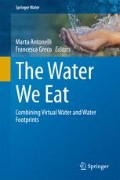Abstract
Virtual water trade refers to the implicit content of water in the production of goods and services. When trade is undertaken, there is an implicit exchange of water. In countries where water is relatively scarce, water-intensive goods are expensive to produce, so that imports normally exceed exports and the economy virtually imports water. This paper provides some estimates of virtual water trade patterns in the Mediterranean, which is an area where water is scarce, unevenly distributed, and progressively insufficient because of climate change and reduced precipitation. We analyse two cases: the current virtual water trade structure, related to trade in agricultural goods, and a future scenario, simulated by means of a computable general equilibrium model, where reduced agricultural productivity, induced by lower water availability, is taken into account.
Access this chapter
Tax calculation will be finalised at checkout
Purchases are for personal use only
Notes
- 1.
See: http://www.gtap.org.
- 2.
Classes are as follows: 500–1000 Mm3, 1000–3000 Mm3, 3000–7000 Mm3, >7000 Mm3.
- 3.
Water Availability and Security in Southern Europe and the Mediterranean Region (WASSERMed) is a research project funded by the European Commission in the 7th Framework Programme (contract no. 244255). For more information, see http://www.wassermed.eu.
- 4.
We considered that changes in precipitation do not automatically translate into changes in total water availability. Details and data of the elaboration process are obtainable from the authors upon request.
- 5.
- 6.
The group includes Croatia and Turkey as accession countries.
References
Allan, J. A. (1993). Fortunately there are substitutes for water otherwise our hydro-political futures would be impossible. In ODA, priorities for water resources allocation and management (pp. 13–26). London: ODA.
Antonelli, M., Roson, R., & Sartori, M. (2012). Systemic input-output computation of green and blue virtual water ‘flows’ with an illustration for the mediterranean region. Water Resources Management. doi:10.1007/s11269-012-0135-9
Atkinson, G., Hamilton, K., Ruta, G., & van der Mensbrugghe, D. (2010). Trade in ‘virtual carbon’—empirical results and implications for policy. Policy Research Working Paper 5194. Washington, D.C.: The World Bank.
Chapagain, A. K., & Hoekstra, A. Y. (2004). Water footprints of nations, Vol. 2: Appendices. Value of water research report series No. 16, UNESCO-IHE Delft.
Gerten, D., Heinke, J., Hoff, H., Biemans, H., Fader, M., & Waha, K. (2011). Global water availability and requirements for future food production. Journal of Hydrometeorology, 12, 885–899.
Hertel, T. W., & Tsigas, M. (1997). Structure of GTAP. In T. W. Hertel (Ed.), Global trade analysis: Modeling and applications. New York: Cambridge University Press.
Hirji, R., & Davis, R. (2009). Environmental flows in water resources policies, plans, and projects: Case studies. Washington, D.C.: The World Bank Environment Department.
Hoekstra, A. Y. (2003). Virtual Water: an Introduction. In A. Y. Hoekstra (Ed.), Virtual water trade. In Proceedings of the International Expert Meeting on Virtual Water Trade. Value of Water Research Report Series No. 12. The Netherlands: IHE Delft.
Korsgaard, L. (2006). Environmental flows in integrated water resources management: Linking flows, services and values. Institute of Environment & Resources: Technical University of Denmark.
National Geographic. (2010). Water—our thirsty world, Special Issue (US Ed.), April 2010. Washington, D.C.: National Geographic Society.
UNEP—Plan Bleu. (2006). Facing water stress and shortage in the Mediterranean, Blue Plan Notes no. 4, October 2006.
United Nations Secretariat. (2010). World population prospects: The 2010 revision. Department of Economic and Social Affairs. http://esa.un.org/unpd/wpp/index.htm
Yang, H., & Zehnder, A. (2007). Virtual water: An unfolding concept in integrated water resources management. Water Resources Research, 43(12), 1–10.
Acknowledgments
This study has been partly funded and realized in the context of the EU FP7 project WASSERMed (Grant Agreement Number 244255, http://www.wassermed.eu). Ana Iglesias and Sonia Quiroga helped us in several ways during the development of this work, most notably in the definition of the water availability scenario. Marta Antonelli provided essential data on non-agricultural water consumption. The usual disclaimer applies.
Author information
Authors and Affiliations
Corresponding author
Editor information
Editors and Affiliations
Appendix
Rights and permissions
Copyright information
© 2015 Springer International Publishing Switzerland
About this chapter
Cite this chapter
Roson, R., Sartori, M. (2015). Virtual Water Trade in the Mediterranean: Today and Tomorrow. In: Antonelli, M., Greco, F. (eds) The Water We Eat. Springer Water. Springer, Cham. https://doi.org/10.1007/978-3-319-16393-2_13
Download citation
DOI: https://doi.org/10.1007/978-3-319-16393-2_13
Published:
Publisher Name: Springer, Cham
Print ISBN: 978-3-319-16392-5
Online ISBN: 978-3-319-16393-2
eBook Packages: Earth and Environmental ScienceEarth and Environmental Science (R0)

